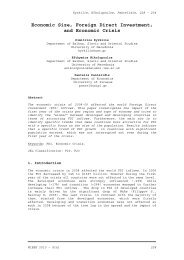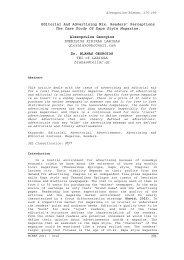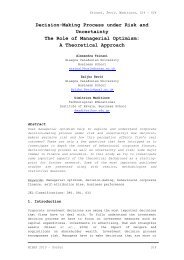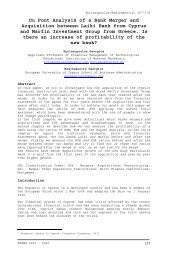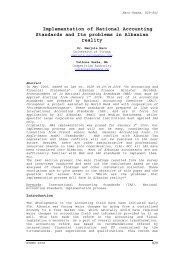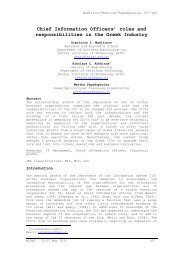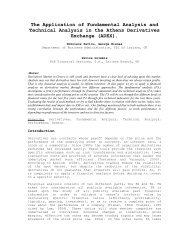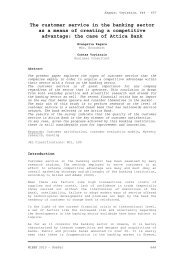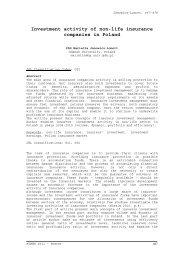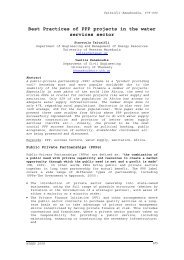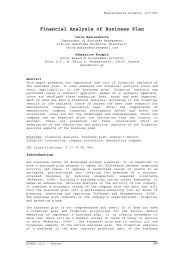Yilmaz B. S., Competitive Advantage Strategies for SMES in ... - mibes
Yilmaz B. S., Competitive Advantage Strategies for SMES in ... - mibes
Yilmaz B. S., Competitive Advantage Strategies for SMES in ... - mibes
Create successful ePaper yourself
Turn your PDF publications into a flip-book with our unique Google optimized e-Paper software.
Burcu Sel<strong>in</strong> <strong>Yilmaz</strong>, 106-117<br />
smaller firm often arises accidentally as a result of particular<br />
operat<strong>in</strong>g conditions surround<strong>in</strong>g the enterprise could be shown as one<br />
of the ma<strong>in</strong> reasons (Jenn<strong>in</strong>gs and Beaver, 1997). In addition, it is<br />
thought that traditional competitive advantage models are not<br />
completely applicable <strong>for</strong> smaller firms because they assume the<br />
existence of scale economies and it is recognized that small firms<br />
cannot compete with larger organizations <strong>in</strong> terms of economies of<br />
scale (O’Donnell, Gilmore, Carson and Cumm<strong>in</strong>s, 2002, p.207).<br />
Complete understand<strong>in</strong>g of a competitive advantage requires a complex,<br />
multidimensional portrayal of all po<strong>in</strong>ts of superiority or deficiency<br />
between a bus<strong>in</strong>ess and its competitors (Day and Nedungadi, 1994). The<br />
creation of a competitive advantage through the development of a<br />
competitive strategy entails the ability to compare the firm’s<br />
position with its competitors. Porter (1991) claimed that, when<br />
<strong>for</strong>mulat<strong>in</strong>g a competitive strategy, managers should be able to<br />
identify the competitors constitut<strong>in</strong>g their <strong>in</strong>dustry. <strong>Competitive</strong><br />
advantage has been used <strong>in</strong>terchangeably with “dist<strong>in</strong>ctive competence”<br />
to mean comparative superiority <strong>in</strong> skills and resources. <strong>Competitive</strong><br />
advantage is often appraised <strong>in</strong> relation to <strong>in</strong>dustry structures,<br />
products, markets, customers, strategies, and communication. It has<br />
also been used <strong>for</strong> describ<strong>in</strong>g positions of superiority based upon the<br />
provision of superior customer value or the achievement of lower<br />
relative costs and the result<strong>in</strong>g market share and profitability<br />
per<strong>for</strong>mance. The sources of competitive advantage <strong>for</strong> firms are<br />
superior skills and resources (Day and Wensley, 1988). These sources<br />
of advantage act as structural determ<strong>in</strong>ants or drivers of cost or<br />
differentiation advantages (Porter, 1985). An organization’s<br />
capabilities can lead to a positional advantage based upon <strong>in</strong>novative<br />
offer<strong>in</strong>gs or superior service. Companies that possess such an<br />
advantage could have superior per<strong>for</strong>mance. The resource based view<br />
(RBV) perspective focuses serious attention on resources, which can be<br />
def<strong>in</strong>ed as assets that are tied semi-permanently to the firm (Hult and<br />
Ketchen, 2001, p.900). Resources are the tangible and <strong>in</strong>tangible<br />
assets a firm uses to choose and implement its strategies (Barney,<br />
2001; p.54). Accord<strong>in</strong>g to the RBV, unique assets, such as patents and<br />
reputations, are more important than others. Unique assets are<br />
difficult <strong>for</strong> competitors to replicate and thus serve to differentiate<br />
their possessors. It is suggested that market orientation,<br />
entrepreneurship, <strong>in</strong>novation, and organizational learn<strong>in</strong>g constitute<br />
unique resources <strong>in</strong>dependently, but rather that they can collectively<br />
contribute to the creation of a unique resource. Each of these four<br />
elements are necessary but are not <strong>in</strong>dividually sufficient <strong>for</strong><br />
creat<strong>in</strong>g positional advantage. Each element is adequate to offer<br />
strengths, but together they can help a firm be uniquely competitive<br />
(Hult and Ketchen, 2001, p.900).<br />
Entrepreneurship refers to the quest of new market opportunities and<br />
the renewal of exist<strong>in</strong>g areas of operation. Entrepreneurial<br />
organizations could per<strong>for</strong>m well <strong>in</strong> dynamic environments, but not <strong>in</strong><br />
regulated markets. They have low per<strong>for</strong>mance <strong>in</strong> stable environments<br />
because the slow pace of change <strong>in</strong> these sett<strong>in</strong>gs rewards efficiently<br />
exploit<strong>in</strong>g extant opportunities, not aggressiveness. There<strong>for</strong>e,<br />
entrepreneurship could be beneficial <strong>in</strong> many contexts, but does not,<br />
by itself, provide a susta<strong>in</strong>able competitive advantage (Hult and<br />
Ketchen, 2001; pp.901-902).<br />
Innovativeness is present when the implementation of new ideas,<br />
products, or processes is encouraged. Innovation is a critical<br />
MIBES 2008 109



